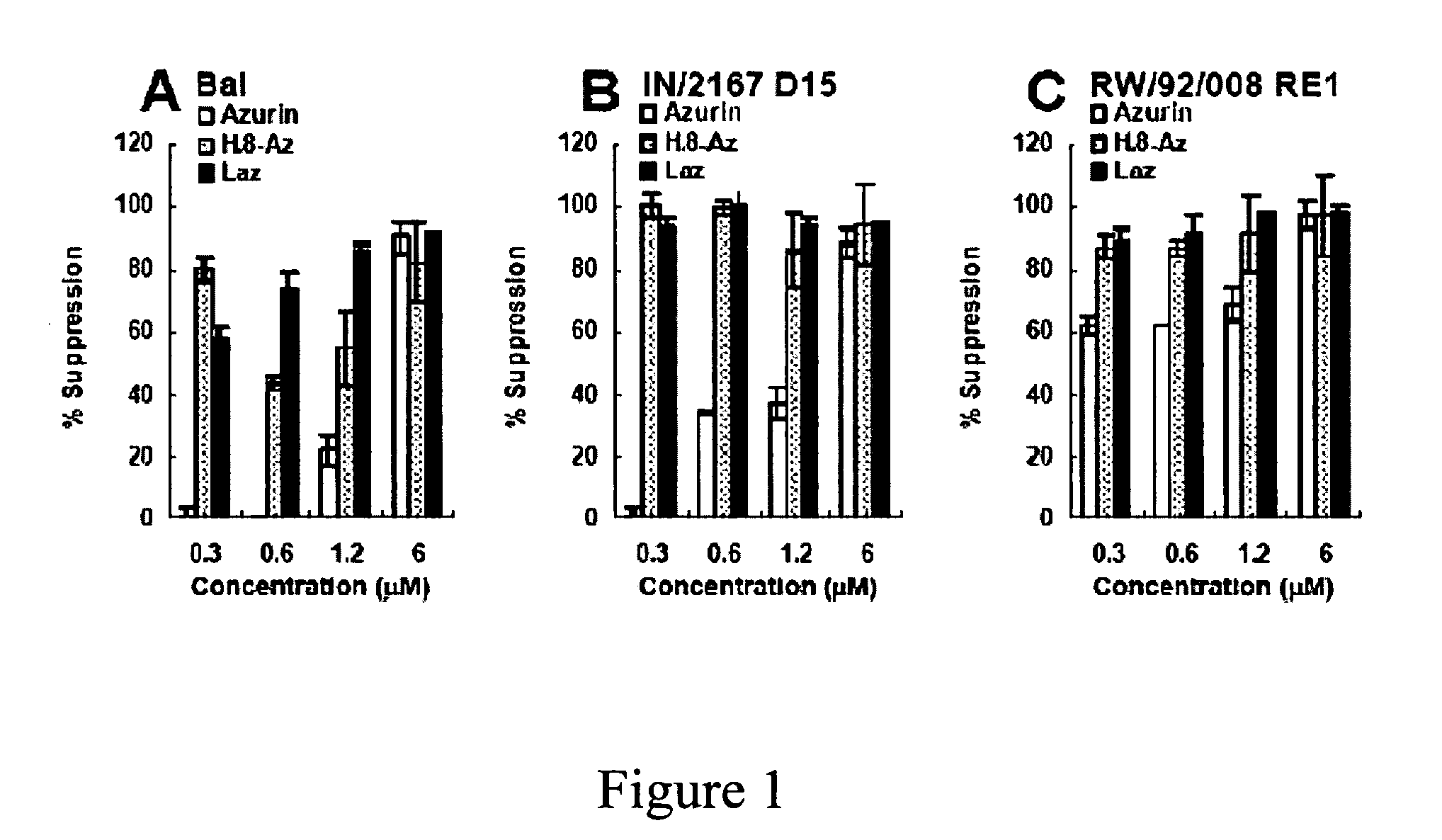Compositions and methods for treating HIV infection with cupredoxin and cytochrome c
a technology of cytochrome c and cupredoxin, which is applied in the field of cupredoxin, can solve the problems of not being able to cure, not being able to prevent the progression of chronic infection or acute aid, and not being able to use antiviral drugs alone or in combination, so as to inhibit the growth of hiv-1 infection, inhibit viral infection, and inhibit the effect of viral infection
- Summary
- Abstract
- Description
- Claims
- Application Information
AI Technical Summary
Benefits of technology
Problems solved by technology
Method used
Image
Examples
example 1
In Vivo Inhibition of HIV Infection of Lymphocytes by Azurin Mutant and Cytochrome C551
[0152]The M44KM64E mutant of azurin was mixed with cytochrome C551 on a 1:1 basis (1 μM azurin: 1 μM cytochrome C551). HIV-infected human blood lymphocytes were incubated with the mixed azurin / cytochrome c551 proteins at concentrations of 0, 500 to 1000 μg / ml protein for 7 days. The HIV p24 levels were then measured in the infected lymphocytes. p24 levels are known to be colinear with HIV virus levels in infected blood. Measuring the change in p24 concentrations in blood will indicate the change of HIV virus titer in the blood. Controls with non-infected human blood lymphocytes were also run in a parallel manner. After the 7 day incubation, the HIV p24 levels in the infected lymphocytes were reduced by 25% to 90% as compared to the control infected lymphocytes with 0 μg / ml azurin and cytochrome c551. In the non-infected control cells, after 7 days of incubation with the protein mixture, neither ce...
example 2
Azurin Exhibits Structural Similarity with ICAM-1 from HIV-1
[0153]Previous studies (Gough & Chothia, Structure 12:917-925 (2004); Stevens et al., J. Mol. Recognit. 18:150-157 (2005)) have shown that cupredoxins show structural similarity to the variable domains of the immunoglobulin superfamily members. The DALI algorithm (Holm & Park, Bioinformatics 16:566-567 (2000)) was used to search the 3D databases for structural homologs of azurin (1JZG) from P. aeruginosa. See, Table 5. Azurin exhibits structural similarity to not only the fab fragment of the monoclonal antibody in complexation with PfMSP1-19, but also to ICAM-1 (Table 5) involved in cerebral malaria (Smith et al., Proc. Natl. Acad. Sci. USA 97:1766-1771 (2000); Franke-Fayard et al., Proc. Natl. Acad. Sci. USA 102:11468-11473 (2005))
[0154]ICAM-1 is not only implicated as a receptor on the endothelial cells in the microvasculture of the brain and other tissues for sequestering P. falciparum—infected erythrocytes, but is also ...
example 3
Effect of Azurin, H.8-Azurin and Laz on HIV-1 Entry and Viral Growth.
[0157]The effect of various concentrations of azurin, H.8-azurin and Laz on the growth of three subtypes of HIV-1 in peripheral blood mononuclear cells (PBMCs), Bal, RW / 92 / 008 / RE1 clade A and IN / 2157 D15 clade C
[0158]Cloning and Expression of the paz and laz Genes. The laz gene from Neisseria gonorrhoeae was cloned based on its known sequence (SEQ ID NO: 19). The P. aeruginosa azurin gene (SEQ ID NO: 1), termed paz, and the sequence of the H.8 epitope of laz from N. gonnerrhoeae (SEQ ID NO: 18), were used to clone in frame the H.8 epitope gene in the 5′-end of paz to produce H.8-paz or in the 3′-end of paz to generate paz-H.8. See, Table 6 for bacterial strains and genetic constructs used in this and related Examples.
[0159]
TABLE 6Bacterial strains and genetic constructsCells / strains / plasmidsRelevant characteristics*ReferenceP. aeruginosaPrototroph, FP-(sex factor minus)Holloway, et al., Microbiol.PAO1Rev. 43: 73-10...
PUM
| Property | Measurement | Unit |
|---|---|---|
| time | aaaaa | aaaaa |
| time | aaaaa | aaaaa |
| concentrations | aaaaa | aaaaa |
Abstract
Description
Claims
Application Information
 Login to View More
Login to View More - R&D
- Intellectual Property
- Life Sciences
- Materials
- Tech Scout
- Unparalleled Data Quality
- Higher Quality Content
- 60% Fewer Hallucinations
Browse by: Latest US Patents, China's latest patents, Technical Efficacy Thesaurus, Application Domain, Technology Topic, Popular Technical Reports.
© 2025 PatSnap. All rights reserved.Legal|Privacy policy|Modern Slavery Act Transparency Statement|Sitemap|About US| Contact US: help@patsnap.com



